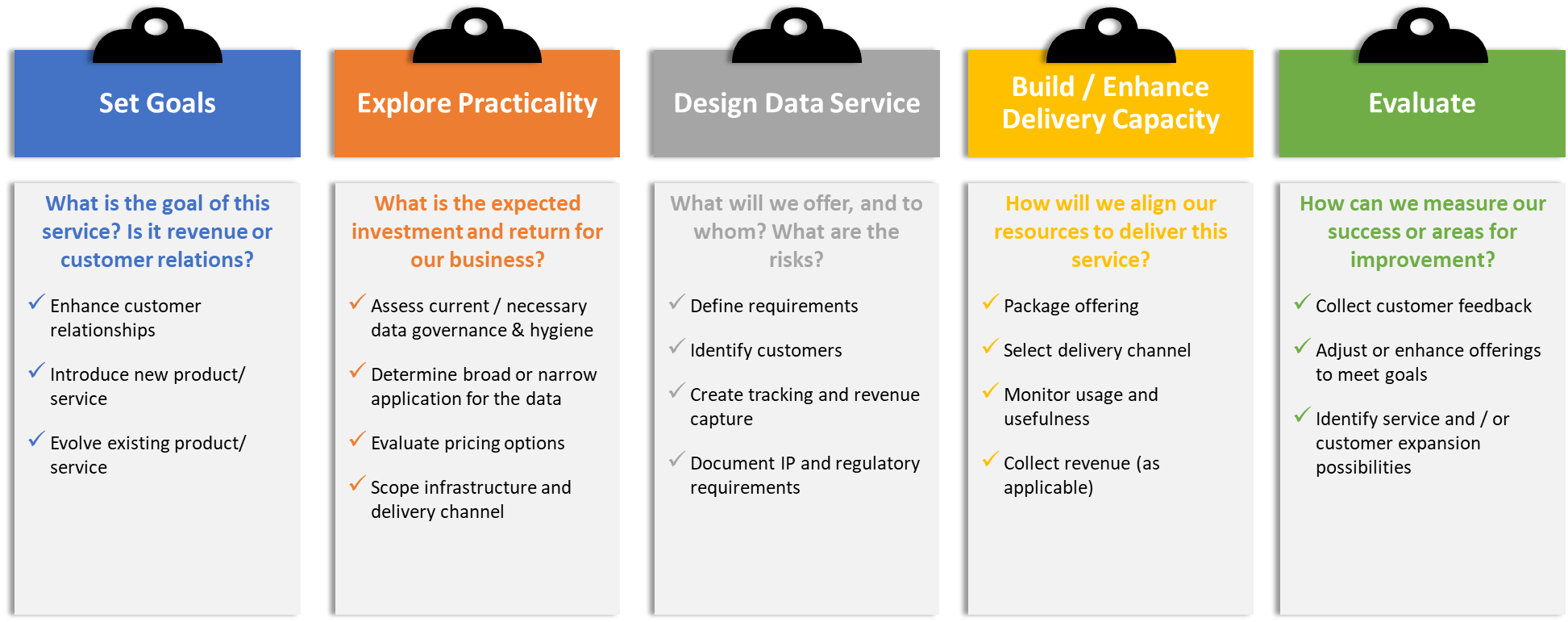No one questions that companies should do more to get a better Return on Investment in Data (ROID) – but we at IDC get a lot of questions about how companies should go about getting actual, countable revenue from their data. When I get this type of inquiry from one of our clients, I begin by asking them WHY they think they should be monetizing their data. It’s the first question that you should ask yourself because the motivation behind that decision propels many aspects used to determine the best path forward.
Five important questions can lead you through the lifecycle of creating, marketing, delivering and evaluating a data as a service offering for your business. This illustration highlights key areas on the path from concept to reality, along with the essential questions to answer as you build data-as-a-service (DaaS) for your company.

1. What is the Goal of this Service?
First, set the goals for your DaaS. When I speak with clients about their goal, nearly everyone pauses when I ask whether the goal is to increase revenue or add value (and stickiness) to their existing product or service. This decision is critical and shapes the work that answers all the subsequent questions. Data can be used for more than one offering, or to meet more than one goal – but it makes sense to focus on either revenue or value-add to begin.
2. Is It Practical for your firm to provide the Service You’ve Outlined?
Like any other new offering or enhancement, a DaaS offering ought to go through a product development process where the team assesses the potential market, pricing, and capability of the firm to deliver either on its own or in combination with partners. Most of the firms that contact me have not sold, licensed or exchanged data before and must consider a list of considerations before they’d design a service for a particular market. It might make sense to consider using a data marketplace and its associated services.
3. What Will We Offer? To Whom?
Once you’ve gone through an assessment of the potential and have the go-ahead to pursue DaaS, you need to get into the specifics of making this a reality. This is question set number 3. This takes technical SMEs, marketing and sales resources, and probably some customer support. Different choices change the level of effort and investment that may be necessary to deliver.
4. How Will We Align Resources to Offer This Service?
The fourth question in the progression of offering DaaS is about aligning resources. With so much demand for data, some companies feel like if they build a DaaS offering, there will be a steady stream of potential buyers just knocking on the door, looking for their data. IDC has found that to make these offerings successful, packaging and delivery are fundamental – just as important as data quality and relevancy. Most buyers need to have the use case clearly identified so that they can get authorization for purchase and see the immediate applicability of the DaaS. Another key point is the integration of the DaaS data with the tools and data that the customer has in-house. In IDC’s most recent user survey, 24% of buyers said that integrating with enterprise applications creates a high level of challenge for sourcing external data.
5. How Can We Measure Our Success?
The fifth question – and the one that never ends – is how are we doing? Like any other product or service your company offers, you have to evaluate how the service is being accepted, what changes and upgrade you ought to make, and continue to scan the competitive environment. Because many of the DaaS options are relatively new, change is going to be quite dynamic over the next few years.
Sometimes you just want to check in, see how your idea compares in the market, or get suggestions about potential partners. I’m very interested to hear new ideas – so get in touch!
Want to hear the key predictions that will impact the DaaS, business analytics and artificial intelligence markets over the next few years?




